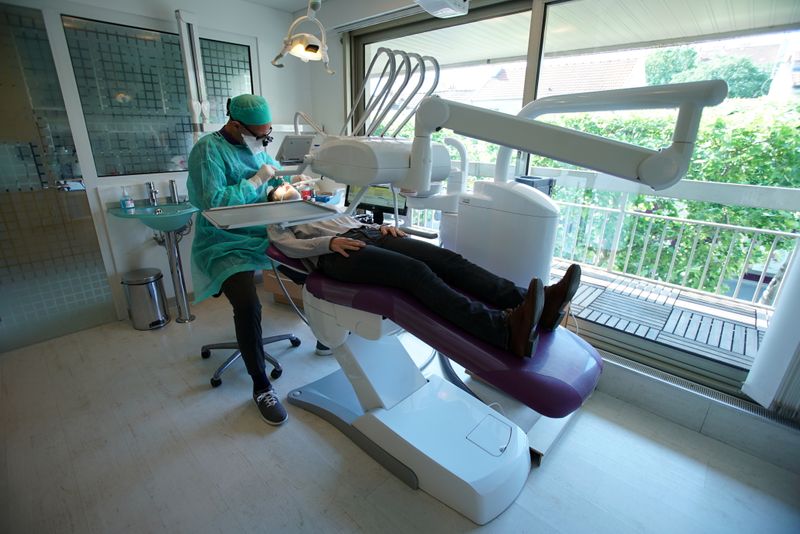CHICAGO(Reuters) – Almost half of Americans enrolled in Medicare did not visit a dentist in 2018. That is a problem that goes far beyond having white teeth or a beautiful smile – poor dental care can exacerbate serious chronic medical conditions, such as diabetes and cardiovascular disease.
The low frequency of dental visits surfaced in a recent report by the Kaiser Family Foundation. It points to a fundamental gap in Medicare coverage – one that Democrats in the U.S. Congress hope to close as part of the $3.5 trillion budget reconciliation package https://www.reuters.com/world/us/us-senates-reconciliation-process-its-not-way-it-sounds-2021-08-10 now under consideration. The legislation would create a standard benefit in Medicare for dental, vision and hearing care. That would be a game-changer for Medicare, and for seniors.
Traditional Medicare pays for dental care only when it is deemed necessary as part of a covered procedure — for example, a tooth extraction needed in preparation for radiation treatment. The program does not cover hearing aids or exams, or most vision care. Most Medicare Advantage plans offer some level of dental, vision and hearing care, but most plans cap annual dollar coverage at levels that will not protect enrollees from more expensive procedures and care.
All three types of coverage are critical to good health. Health researchers have linked poor dental care to higher rates of diabetes, cardiovascular disease and pulmonary infections. And they have found that vision and hearing loss are associated with a higher risk of falls, depression and cognitive impairment.
Seniors face especially high out-of-pocket costs for dental care, especially for pricier procedures such as implants. The Kaiser report https://www.kff.org/medicare/issue-brief/medicare-and-dental-coverage-a-closer-look, based on Medicare data, found that average out-of-pocket spending in 2018 among enrollees who did access care was $874. Twenty percent spent more than $1,000, and one in ten spent more than $2,000. (https://bit.ly/3m6QVak)
Medicare Advantage plans typically cover both preventive care, like oral exams, cleanings and x-rays, and more extensive benefits for procedures such as fillings, extractions and root canals.
Advantage enrollees often get these dental benefits without paying an additional premium. That is possible because Advantage plans operate under a complex system of payments that include bonuses paid to plans by the government based on quality ratings, and rebates. Advantage plans are required to spend part of these bonus payments directly on care for beneficiaries.
And a new Kaiser brief https://bit.ly/3ARFXcZ published this week found that federal Medicare outlays swelled by $7 billion in 2019 as a result of higher payments to Advantage plans. The additional spending includes the cost of extra benefits. (https://bit.ly/3ARFXcZ)
HIGH OUT-OF-POCKET COSTS
Extra benefits such as dental have helped fuel the rapid growth of Advantage plans. The Congressional Budget Office forecast recently that Advantage plans will account for half of all Medicare enrollment by 2025 – double what it was in 2010.
But Kaiser found that the average annual limit on dental coverage among Advantage plans that offer more extensive benefits is about $1,300 this year, and 59% of enrollees in these plans have dental benefits that are capped at $1,000 or less. Some seniors purchase commercial dental policies, but these plans also come with coverage caps similar to those found in Advantage plans.
The bill for extensive dental procedures often exceeds these caps. A patient needing a combination of extractions, root canals and crowns might easily pay upwards of $4,000, data from the American Dental Association shows.
High out-of-pocket costs explain why so many seniors simply go without dental care. The median income for Medicare beneficiaries in 2019 was just $29,650, Kaiser reports. A study https://bit.ly/3g9EBCx published last year in Health Affairs found that 27% of low-income Medicare beneficiaries had visited a dentist in the previous 12 months, compared with 73% of high-income beneficiaries (https://bit.ly/3g9EBCx).
The racial gaps in care are equally appalling. Kaiser found that 68% of Black beneficiaries – and 61% of Latino beneficiaries – did not visit a dentist in the past year.
“People of color who are on Medicare are disproportionately low-income, so even if they have a dental benefit through Advantage, they may find dental care unaffordable,” said Tricia Neuman, executive director of the Medicare policy program at the Kaiser Family Foundation. “This does appear to be a health equity issue, based on what we’re seeing with people not going to the dentist at all in a given year.”
Senate Democrats aim to add dental, vision and hearing care to Medicare through the budget reconciliation package https://www.reuters.com/world/us/us-senate-democrats-rush-outline-massive-infrastructure-bill-2021-07-13 now under discussion in Congress. Just how this might be done will depend on their negotiations, but one template can be found in the Elijah E. Cummings Lower Drug Costs Now Act, which was passed by the House of Representatives in 2019. That bill would cover dental care under Medicare Part B. Medicare would cover 80% of the preventive and basic care, and gradually increase coverage for more costly treatments.
The reconciliation bill is so sweeping in scope that a change like this easily flies under the radar. But it would be the most positive change made to Medicare in many years.
(Writing by Mark Miller; Editing by Matthew Lewis)




















